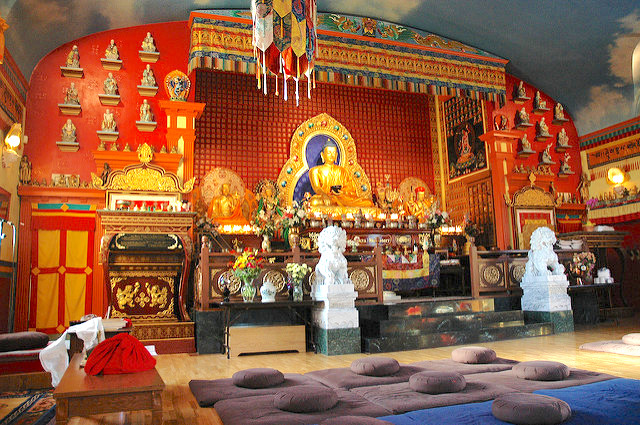
{Cutting Through} is a new column on elephantjournal.com. Have a question about meditation, mindfulness, or Buddhism? Please send it to Travis at [email protected] or in a comment on this article. Travis is an authorized meditation instructor in the Shambhala Buddhist lineage and the Center Director of Shambhala St. Petersburg. He is a joyful student of Sakyong Mipham Rinpoche.
Question for your column: “I want to learn meditation, and some things about Buddhism resonate with me, but honestly I’m really not into religion and I find a lot of the Buddhist language and practices are hard for me to get into because they feel religious. What should I do?”
~
This is a great question, and there’s so much to say about it!
Let’s start with the beginning of what you wrote: you want to learn meditation.
In my opinion, there isn’t anything particularly religious about the the type of meditation that we do in Shambhala, called shamatha, or peaceful abiding.
I’ve written a lot about what this practice is about before (and will link those articles at the bottom), so I won’t go into that a lot here.
But, as briefly as popsicle, shamatha meditation is a practice of learning to break our habits of being perpetually spinning in the conditioning of our discursive mind, and learning to instead tame and settle our minds in order connect with the deep well of health, sanity, and contentment that lies underneath all of our conceptual and habitual ways of thinking and being.
The technique is very simple in theory and is explained here by my teacher, Sakyong Mipham Rinpoche. The object of our meditation with this technique is our breath—feeling our body as it breathes—and, simply: when we lose our mind, we come back. When distracted, we notice, and return to the feeling of our body breathing.
Anyway, to me, it is easy to see this practice as a form of behavioral therapy, as much as anything else. It’s a way to tame and train our minds. It’s really basic and bare bones.
In this sense, meditation is a secular practice. There are other practices that involve visualizations, chanting mantras, and so on, but this basic mindfulness/awareness meditation technique is not religious.
You also mentioned that there are aspects of Buddhism that resonate with you, but others that don’t. This brings to me the famous quote from the Dalai Lama:
“Do not try to use what you learn from Buddhism to be a Buddhist; use it to be a better whatever-you-already-are.”
So, obviously he’s not so good at proselytizing. But, basically, you’ve been given permission by the highest figure in Tibetan Buddhism to do exactly what you’re looking to do.
You can practice mindfulness meditation, read a book about being more compassionate in your relationships, try to be more considerate of others’ needs, and use all of these tools to make you a better (Christian, Atheist, Flying Spaghetti Monsterist) person.
On the other hand…
It is said that there are three aspects of being a dharma practitioner: hearing/studying the teachings, contemplating them or mulling them over in your mind to see if they are true to your experience, and meditation where the other two are assimilated. Traditionally, we are taught that each of these three things are equally important—meaning, seemingly, that we should devote and equal amount of time and effort to each of them.
I studied Buddhist teachings intensely for about five years before I ever really started to develop any type of meditation practice. While I was blown away and connecting very much to the teachings, my general experience didn’t really change until I started meditating regularly. That is when my actual being began to change (as opposed to my conceptual mind only). So, I tend to believe the threefold formula mentioned above.
I also think it’s unfortunate that our past experiences with religion prevent us from being open to the experience of something like Buddhism, which is, in my opinion, so utterly different than the three major Western religions that they shouldn’t really even be grouped together as one thing.
I’ve seen people be triggered by many minor things because of their previous unpleasant experiences with religion. I’ve heard this described (by me), for example, as Post Traumatic Catholic Disorder. I feel lucky now to have grown up in a situation where I wasn’t saddled with the baggage that would prevent me from connecting with the great tradition I have been involved with now for the past 15 years. There are also many people who have been able to connect and benefit from Buddhism in a remarkable and admirable way even after earlier religious trauma.
The Buddhist teachings present a totally different worldview than Christianity, Islam, and Judaism. One of the important parts of studying the teachings deeply is that we begin to see the world in the way that these great teachers and practitioners from the past have done in an unbroken lineage for over 2,600 years. This is much better than seeing the Buddhist teachings through a Christian lens—it doesn’t really work.
There is a chapter in Pema Chödrön’s book The Wisdom of No Escape called “Stick to One Boat.” It addresses the potential trap of the “spiritual shopper.” While we discussed a healthy and mature way earlier to use parts of what are taught in Buddhism to make us a better “whatever we already are,” we want to be careful about picking and choosing things from a bunch of different traditions in an effort to create our own spirituality. With “spiritual shopping,” what is lacking is the solid foundation of having one main path; it’s just a hodge podge of all the “light” devoid of the “dark” or challenging parts.
Pema warns:
“The point is it’s best to stick to one boat, so to speak, whatever that boat may be, because otherwise, the moment you begin to hurt, you’ll just leave or you’ll look for something else.”
This is a cowardly way to approach our spiritual practice, and it likely won’t get us very far. Pema is saying here that it is best to pick one thing, commit to it, and let it put us through our changes. If we jump ship every time something hits a little too close to home, we’ll never have a real opportunity to grow—and we’ll just reinforce the habit of running away whenever something starts to feel uncomfortable. So, we have to be careful and mindful of what we’re really up to.
There seems to be two factors at work when talking about Buddhism, generally: the teachings and the culture from which they came. I have visited Buddhist groups in the West that seemed more like Tibetan Buddhist cosplay than genuine spiritual practice. We don’t need to become Tibetan or Japanese to practice Buddhism.
Ponlop Rinpoche put it this way:
“The essence of Buddhism is like pure water; it is wisdom that is transparent and fluid. Like pure water, it is without any inherent shape or color of its own. Yet at the same time it is capable of adopting any shape and reflecting all the colors of the container into which it is poured. It is a science of mind and a philosophy of life that addresses the emotions as well as the intellect and offers a basis for understanding the meaning of life and the nature of the world.
Historically, as Buddhism traveled from its homeland of India to other lands—to Tibet, China, Sri Lanka, Japan and so on—this pure water, the genuine wisdom of Buddha, took on the shape of its different containers and reflected the languages and social forms of each country.
This is the water Chögyam Trungpa Rinpoche [the founder of Shambhala Buddhism] began pouring from his Tibetan container into the vessel of Western culture, to quench the thirst of beings overwhelmed by poverty mentality and spiritual materialism. Thus Chögyam Trungpa Rinpoche played a very important role in bringing the complete buddhadharma to the West.”
When Chögyam Trungpa poured the water of pure dharma into the container of the the West, new forms and symbolism were developed and a new American Buddhism emerged. There is nothing diluted about it; it (Shambhala Buddhism) is, in fact, seemingly, more relevant and potent to our times and culture than something created for people of a different time and place (these would be cultural aspects, as the dharma itself is universal and timeless).
So, sometimes, when something feels too similar to our bad experiences with other religions, it’s because it is—and we should run away. With Buddhism, like with the many denominations of Christianity, there are a ton of different styles and sects. We shouldn’t judge the whole of Buddhism by any one of them.
The key seems to be to find what most resonates with us, and make that our main thing. Then, if there are some pieces of other traditions that we can use to supplement our growth and self-actualization, those pieces will be welcome and beneficial additions.
What is the best way to overcome “foreignness”? To become familiar with what is foreign, and see it for what it is. Once we’ve done that, we can make decisions based on our own wisdom and reasoning rather than our conditioned and habitual reactions.
~
Relephant Reads from Travis:
{Cutting Through}: Anger. When will Meditation Stop my Feelings of Anger? {Weekly Q & A}
{Cutting Through}: The Four Noble Truths. Isn’t suffering important for growth? {Weekly Q & A}
The Simple Technique that Changed My Life.
Meditation is Essentially Addressing this One Point.
~
~
~
Author: Travis May
Image: Flickr/Wonderlane
Copy Editor: Callie Rushton
Social Editor: Waylon Lewis








Read 0 comments and reply